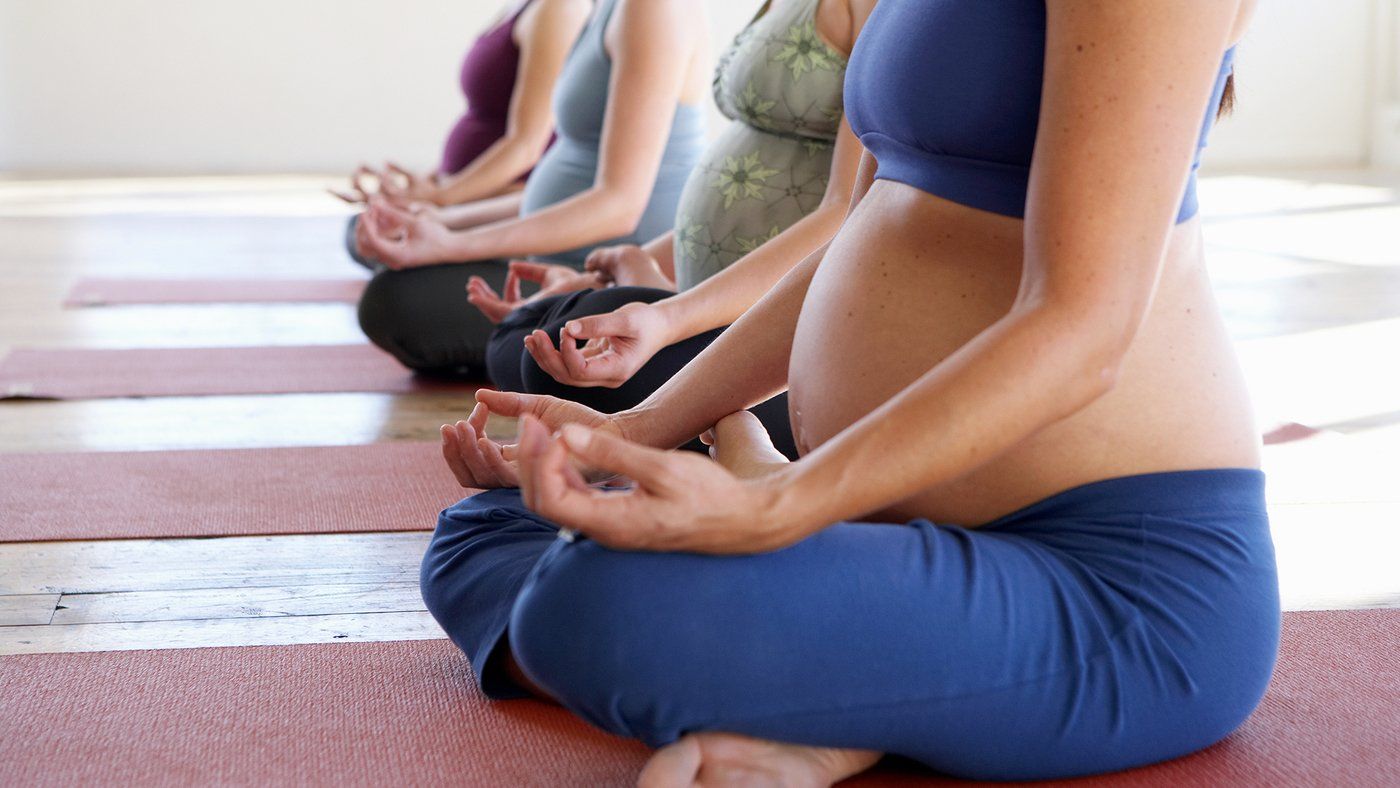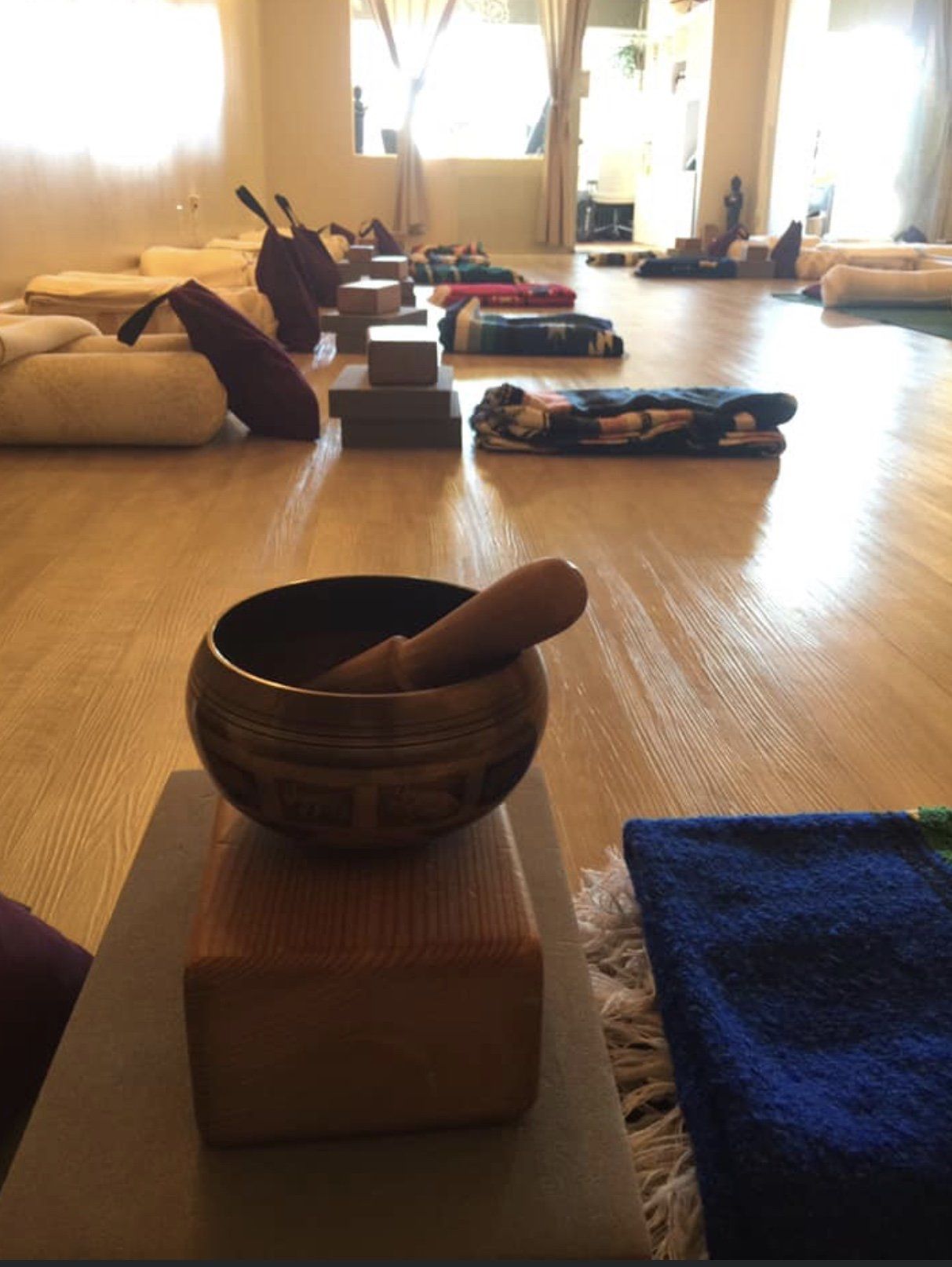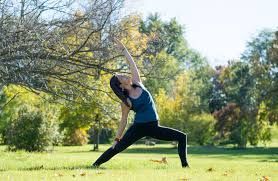EXTRA GENTLE YOGA FOR FIBROMYALGIA
- By Jeanne Dillion
- •
- 23 Apr, 2018
- •
ABOUT FIBROMYALGIA
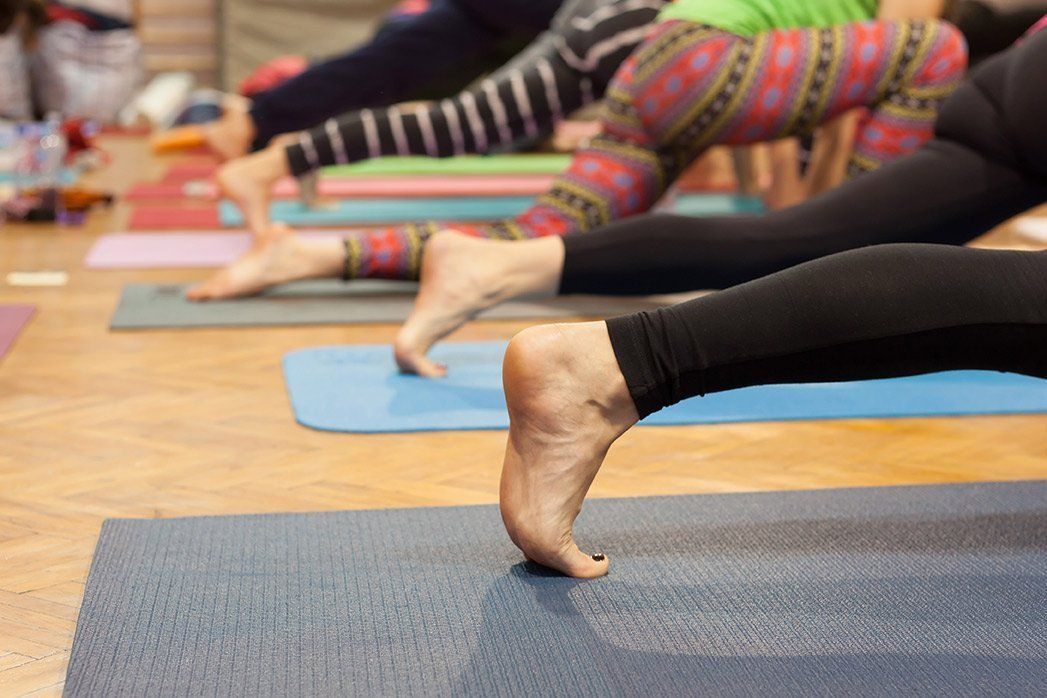
Fibromyalgia Syndrome (FMS) comes from the Latin root words: “fibro,” meaning connective
tissue fibers, “my,” muscle, “al,” pain, and “gia,” condition of. Merriam-Webster’s Collegiate
Dictionary defines “syndrome” as “a group of signs and symptoms that occur together and
characterize a particular abnormality.”
Dr. William Balfour of the University of Edinburgh first described FMS in 1816. For many
years the medical profession had various labels for FMS, including chronic rheumatism,
myalgia, pressure point syndrome, and fibrositis. Often viewed as a psychological condition, in
1987, FMS was finally recognized by the American Medical Association as a true illness and a
major cause of disability.
Symptoms and Diagnosis
Due to its varied symptoms, diagnosis of FMS can be challenging. Symptoms can include: difficulty sleeping, loss of hearing, blurred vision, falls, itching, pelvic pain, soft tissue aches and pains, and irritable bowel syndrome. Many people with FMS ill complain of fatigue and nonrestorative sleep and say, “I hurt all over.” An official diagnosis for FMS was the result of the Copenhagen Declaration establishing fibromyalgia as an officially recognized syndrome on January 1, 1993, for the World Health Organization. (See, www.cmq.org/fibroang.pdf.) The Declaration defines FMS as a painful, non-articular condition predominantly involving muscles and as the most common cause of chronic, widespread musculoskeletal pain. The Declaration also states that FMS is “part of a wider syndrome encompassing headaches, irritable bladder, dysmenorrhea, cold sensitivity, Raynaud’s phenomenon, restless legs, atypical patterns of numbness and tingling, exercise intolerance and complaints of weakness.” People with FMS often suffer from depression and anxiety. Not surprising with all the possible physical symptoms.
In 1990, the American College of Rheumatology defined the points of FMS and the World Health Organization considered the definition as suitable for research purposes. The following symptoms were then added to the official diagnosis criteria: “ . . . the presence of unexplained widespread pain or aching, persistent fatigue, generalized morning stiffness, non-refreshing sleep, and multiple tender points. Most patients with these symptoms have at least 11 tender points. But a variable proportion of otherwise typical patients may have less than 11 tender points at the time of the examination.” The Copenhagen Declaration definition states that you must have at least 11 of 18 specified tender points to be diagnosed with FMS. The pressure used to test for pain should be enough to whiten the thumbnail when pressing on the points.
Symptoms and Diagnosis
Due to its varied symptoms, diagnosis of FMS can be challenging. Symptoms can include: difficulty sleeping, loss of hearing, blurred vision, falls, itching, pelvic pain, soft tissue aches and pains, and irritable bowel syndrome. Many people with FMS ill complain of fatigue and nonrestorative sleep and say, “I hurt all over.” An official diagnosis for FMS was the result of the Copenhagen Declaration establishing fibromyalgia as an officially recognized syndrome on January 1, 1993, for the World Health Organization. (See, www.cmq.org/fibroang.pdf.) The Declaration defines FMS as a painful, non-articular condition predominantly involving muscles and as the most common cause of chronic, widespread musculoskeletal pain. The Declaration also states that FMS is “part of a wider syndrome encompassing headaches, irritable bladder, dysmenorrhea, cold sensitivity, Raynaud’s phenomenon, restless legs, atypical patterns of numbness and tingling, exercise intolerance and complaints of weakness.” People with FMS often suffer from depression and anxiety. Not surprising with all the possible physical symptoms.
In 1990, the American College of Rheumatology defined the points of FMS and the World Health Organization considered the definition as suitable for research purposes. The following symptoms were then added to the official diagnosis criteria: “ . . . the presence of unexplained widespread pain or aching, persistent fatigue, generalized morning stiffness, non-refreshing sleep, and multiple tender points. Most patients with these symptoms have at least 11 tender points. But a variable proportion of otherwise typical patients may have less than 11 tender points at the time of the examination.” The Copenhagen Declaration definition states that you must have at least 11 of 18 specified tender points to be diagnosed with FMS. The pressure used to test for pain should be enough to whiten the thumbnail when pressing on the points.

RESEARCH AND STUDIES SUPPORT COMPLEMENTARY TREATMENTS
According to scientists at the University of Missouri-Columbia, “Patients with fibromyalgia syndrome (FMS) who exercise and practice relaxation and other non-drug techniques report fewer symptoms such as pain, fatigue, and morning stiffness than do patients who receive medication alone. * * * Optimal treatment of FMS should include non-pharmacological interventions, specifically exercise and cognitive behavioral therapy, in addition to appropriate medication management as needed for sleep and pain symptoms,” says Lynn A. Rossy, M.A., head of a study that made these conclusions. (See, www.news.wisc.edu/packages/emotion.)
Another study found meditation helps to quiet the mind and better deal with pain of symptoms and is an effective way to distract oneself from symptoms. (See, www.healthcentral.com/news.)
A study of 18 men and women who had persistent pain for more than three months indicates Yoga may help those with chronic pain. Participants attended 90-minute Yoga sessions three times weekly for 30 days. All 18 patients either experienced some kind of improvement or remained the same. No symptoms increased. (See, www.healthcentral.com/news.)
The theory of visualization bringing a positive outcome was supported by a study demonstrating that people can increase muscle power simply by imagining themselves doing the exercises. Guang Yue led this study at the Cleveland Clinic Foundation’s Lerner Research Institute. (See, http://straitstimes.asia1.com.sg/health/story/0,3324,91956,00.html)
FROM PAIN TO YOGA
Debra Risberg, a Kripalu certified teacher in Illinois, developed FMS 31 years ago at age 16. Debra says, “It was devastating physically and emotionally and the doctors we turned to for help only made things worse by putting me in a painful brace and plying me with tranquilizers to keep me from complaining.” Debra was not given an official diagnosis of FMS until 1987.
A search for freedom from pain led Debra to Yoga. After her Kripalu teacher left town in 1995, she became a certified Yoga teacher. Since then Debra has opened her own studio and teaches students with FMS and chronic pain as well as the general public. When asked how having this condition affects her ability to teach Yoga, she responded, “It helps me to be more sensitive to moving slowly into postures and surrendering to find the deepest release for myself and my students. It keeps me humble. It reminds me of what is truly important because I can't afford to waste precious energy.”
Debra’s class for people with FMS includes gentle and restorative yoga, meditation, deep relaxation and group support. She said, “The group support model I have used involves breaking up into couples or triples and doing co-active listening. Students seem to love that part of the class.”
Debra continued, “You can't apply the same methods to everyone. Some people are so ill and disabled that they can hardly move or stand to be touched. Others can be quite athletic and love deep tissue massage. It depends on the personality, the genetic makeup and how the illness manifests in each individual. Pranayama is also important but something like kapalabhati can be too strong.” Allowing students to relax and breath into sensations can bring an understanding of pain. Meditation teaches one to stop reacting to intense sensations and to begin a more supportive relationship with the body.
For asana practice Debra includes isometrics to release muscles in specific areas. She offers breathing techniques such as the three-part breath, ujayii, and alternate nostril.
Debra hesitates to make diet recommendations because each person is unique in their needs. She did say, “I had no pain when I was in India living on a fresh vegetarian diet. I think the medicinal properties of the spices and herbs in Indian vegetarian cooking are good for me. Also, the food there had no additives or chemicals on it.” Although there is no scientific proof to support the theory, Debra suspects, “[FMS] may be caused by environmental toxins combined with stressful living conditions.” Debra also takes a daily Ayurvedic remedy called Tryphala to help the digestive tract.
THE AUTHOR’S EXPERIENCE
Most of my life I have dealt with pain in some area of my body. Symptoms included soft tissue injuries, structural imbalances, insomnia, chronic illness, general fatigue and depression.
In 1996 some of my symptoms were given the label of FMS. The diagnosis itself was not especially comforting, as there is no known cure for FMS; however, knowing that there were others who had this condition, and that the medical community recognized it, was promising. I wasn’t crazy!
An introduction to Yoga twelve years ago taught me that breathing into sensations can create detachment from (and an acceptance of) symptoms. Gained awareness of daily movements and use of ergonomics in the workplace helped the pain subside. A new attitude toward life led to the desire of sharing this ancient tradition with others. It wasn’t just the physical movement of the asanas -- meditation, visualization, pranayama, and deep relaxation brought a greater sense of knowing my true self. Yoga has been one of the most effective tools for healing. However, it is not a panacea and should be used as an adjunct with other treatment approaches. I became a certified teacher through Integrative Yoga Therapy in 1998.
According to scientists at the University of Missouri-Columbia, “Patients with fibromyalgia syndrome (FMS) who exercise and practice relaxation and other non-drug techniques report fewer symptoms such as pain, fatigue, and morning stiffness than do patients who receive medication alone. * * * Optimal treatment of FMS should include non-pharmacological interventions, specifically exercise and cognitive behavioral therapy, in addition to appropriate medication management as needed for sleep and pain symptoms,” says Lynn A. Rossy, M.A., head of a study that made these conclusions. (See, www.news.wisc.edu/packages/emotion.)
Another study found meditation helps to quiet the mind and better deal with pain of symptoms and is an effective way to distract oneself from symptoms. (See, www.healthcentral.com/news.)
A study of 18 men and women who had persistent pain for more than three months indicates Yoga may help those with chronic pain. Participants attended 90-minute Yoga sessions three times weekly for 30 days. All 18 patients either experienced some kind of improvement or remained the same. No symptoms increased. (See, www.healthcentral.com/news.)
The theory of visualization bringing a positive outcome was supported by a study demonstrating that people can increase muscle power simply by imagining themselves doing the exercises. Guang Yue led this study at the Cleveland Clinic Foundation’s Lerner Research Institute. (See, http://straitstimes.asia1.com.sg/health/story/0,3324,91956,00.html)
FROM PAIN TO YOGA
Debra Risberg, a Kripalu certified teacher in Illinois, developed FMS 31 years ago at age 16. Debra says, “It was devastating physically and emotionally and the doctors we turned to for help only made things worse by putting me in a painful brace and plying me with tranquilizers to keep me from complaining.” Debra was not given an official diagnosis of FMS until 1987.
A search for freedom from pain led Debra to Yoga. After her Kripalu teacher left town in 1995, she became a certified Yoga teacher. Since then Debra has opened her own studio and teaches students with FMS and chronic pain as well as the general public. When asked how having this condition affects her ability to teach Yoga, she responded, “It helps me to be more sensitive to moving slowly into postures and surrendering to find the deepest release for myself and my students. It keeps me humble. It reminds me of what is truly important because I can't afford to waste precious energy.”
Debra’s class for people with FMS includes gentle and restorative yoga, meditation, deep relaxation and group support. She said, “The group support model I have used involves breaking up into couples or triples and doing co-active listening. Students seem to love that part of the class.”
Debra continued, “You can't apply the same methods to everyone. Some people are so ill and disabled that they can hardly move or stand to be touched. Others can be quite athletic and love deep tissue massage. It depends on the personality, the genetic makeup and how the illness manifests in each individual. Pranayama is also important but something like kapalabhati can be too strong.” Allowing students to relax and breath into sensations can bring an understanding of pain. Meditation teaches one to stop reacting to intense sensations and to begin a more supportive relationship with the body.
For asana practice Debra includes isometrics to release muscles in specific areas. She offers breathing techniques such as the three-part breath, ujayii, and alternate nostril.
Debra hesitates to make diet recommendations because each person is unique in their needs. She did say, “I had no pain when I was in India living on a fresh vegetarian diet. I think the medicinal properties of the spices and herbs in Indian vegetarian cooking are good for me. Also, the food there had no additives or chemicals on it.” Although there is no scientific proof to support the theory, Debra suspects, “[FMS] may be caused by environmental toxins combined with stressful living conditions.” Debra also takes a daily Ayurvedic remedy called Tryphala to help the digestive tract.
THE AUTHOR’S EXPERIENCE
Most of my life I have dealt with pain in some area of my body. Symptoms included soft tissue injuries, structural imbalances, insomnia, chronic illness, general fatigue and depression.
In 1996 some of my symptoms were given the label of FMS. The diagnosis itself was not especially comforting, as there is no known cure for FMS; however, knowing that there were others who had this condition, and that the medical community recognized it, was promising. I wasn’t crazy!
An introduction to Yoga twelve years ago taught me that breathing into sensations can create detachment from (and an acceptance of) symptoms. Gained awareness of daily movements and use of ergonomics in the workplace helped the pain subside. A new attitude toward life led to the desire of sharing this ancient tradition with others. It wasn’t just the physical movement of the asanas -- meditation, visualization, pranayama, and deep relaxation brought a greater sense of knowing my true self. Yoga has been one of the most effective tools for healing. However, it is not a panacea and should be used as an adjunct with other treatment approaches. I became a certified teacher through Integrative Yoga Therapy in 1998.
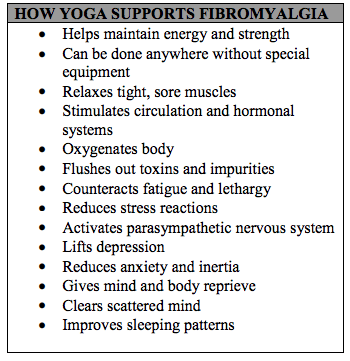
Regular study with teachers who focus on
therapeutic applications of Yoga and
healing of the whole continue to guide me.
After initial training with teachers of
Iyengar and other styles of Yoga, I
discovered the tradition of T.K.V.
Desikachar (sometimes referred to as
Viniyoga in the United States).
Appropriate sequencing and adaptations of
poses to meet individual needs, conscious
linking of breath and movement, together
with specific pranayama practices, sound,
and deep relaxation, has brought profound
levels of healing to me, and my students as
well.
Two qualities must be present in asana practice: stability and alertness (sthira) and comfort (sukha). (See, Yoga Sutra II.46.) Students should not push muscles to point of exertion. When one is unable to perform asana repetitions, suggest mentally visualizing the performance of the movement. Holding poses for too long can cause symptom flare-ups as contracting a muscle for any period of time can activate trigger points. Movement should not be excessive although immobility is another fairly common cause of trigger point flare-ups. Pauses between repetitions allow muscles to relax. Asana practice should always end with a rest in savasana or another restorative posture.
Everyday posture and body mechanics are especially important. How one stands, lifts, sits, walks, and moves can play a big role in sustaining daily energy. If the body is out of balance, strain can result. Avoid sitting in one position for lengthy periods of time as muscle contraction can occur. The body needs to move. Check your body’s alignment often throughout the day
Two qualities must be present in asana practice: stability and alertness (sthira) and comfort (sukha). (See, Yoga Sutra II.46.) Students should not push muscles to point of exertion. When one is unable to perform asana repetitions, suggest mentally visualizing the performance of the movement. Holding poses for too long can cause symptom flare-ups as contracting a muscle for any period of time can activate trigger points. Movement should not be excessive although immobility is another fairly common cause of trigger point flare-ups. Pauses between repetitions allow muscles to relax. Asana practice should always end with a rest in savasana or another restorative posture.
Everyday posture and body mechanics are especially important. How one stands, lifts, sits, walks, and moves can play a big role in sustaining daily energy. If the body is out of balance, strain can result. Avoid sitting in one position for lengthy periods of time as muscle contraction can occur. The body needs to move. Check your body’s alignment often throughout the day
Yoga Nidra practice, also known as body scan, can be effective for healing. Resting deeply
without falling asleep restores the mind and body. (See, www.nondual.com.) Integrating regular
periods of rest into each day, even when you feel well, may prevent flare-ups.
Suggested pranayama techniques include: langhana (lengthening the exhalation) for cleansing the body, sitali (the cooling breath) to promote healing of autoimmune deficiencies such as FMS, and nadi sodhana pranayama, (alternate nasal breathing) to bring balance to bodily systems. Each individual is different and has unique needs; therefore, choosing pranayama techniques to meet those needs is important.
Meditation has been proven to help with chronic pain and depression. By stopping thoughts momentarily, the mind and body experience a rejuvenating break. Sleep patterns and drug dependency may improve as well.
For teachers who struggle with FMS, reducing or eliminating demonstration of poses may help conserve energy needed for healing. This is a beautiful way to practice ahimsa toward self. Refraining from demonstrating can also encourage students to move inward and experience the poses more fully in their own bodies.
Working with a teacher who has therapeutic training and experience is essential. Begin with an extra gentle practice. Remember the line often quoted by seasoned teachers, “If you can breathe, you can do Yoga.” With conscious breathing and simple movements a calming peace can replace fatigue and frustration. Take it easy and listen to your inner wisdom.
Bio
Jeanne Dillion has been the owner of Yoga for Wellness and Back to Basics (an office ergonomics and workplace wellness consulting business) since 1998. She is certified through Integrative Yoga Therapy and a Registered Yoga Teacher. Jeanne has been practicing Yoga since 1990, and has attended trainings with T.K.V. Desikachar and Jon Kabat-Zinn. Jeanne recently released a CD and audiocassette, Extra Gentle Yoga, appropriate for students with FMS and other debilitating conditions. To purchase, go to www.yogaforwellnesspro.com or e-mail her at jeannedillion@cableone.net. A fibromyalgia workshop for Yoga teachers with Debra Risberg will be offered at the Kripalu Yoga Teachers Association Conference October 24 – 27, 2002. Call Kripalu for details.
REFERENCES AND SUGGESTED READING
Bouanchaud, B: The Essence of Yoga, Reflections on the Yoga Sutras of Patanjali, Portland, OR: Rudra Press, 1997. Davis, M, Eshelman, ER, McKay, M: The Relaxation & Stress Reduction Workbook, Oakland, CA: New Harbinger Publications: 1995. Desikachar, TKV: The Heart of Yoga, Rochester, VT: Inner Traditions, 1995. Desikachar, TKV: The Viniyoga of Yoga, Chennai, India: Quadra Press Limited, 2001. Feuerstein, G: The Yoga Perspective on Pain, Mental Health, and Euthanasia, Pain and Pain Management, www.iayt.org/news.php, pp. 3-5. Kabat-Zinn, J: Full Catastrophe Living New York, Delta; 1990. Kraftsow, G: Yoga for Wellness, Arkana: Penguin Group, 1999. Lasater, J: Relax and Renew: Restful Yoga for Stressful Times, Berkeley, CA: Rodmell Press: 1995. Miller, R: The Journal of the International Association of Yoga Therapists, The Psychophysiology of Respiration. 1991. Miller, R: Experiencing Nonduality with Richard C. Miller, Ph.D., www.nondual.com LePage, J: Integrative Yoga Therapy Training Manual. Aptos CA, Printsmith, 1994. Starlanyl, Devin, Copeland, ME, Fibromyalgia & Chronic Myofascial Pain Syndrome A Survival Manual, Oakland, CA: New Harbinger Publications, Inc.: 1996. Salt, WB, Season, EH: Fibromyalgia and the Mind Body Spirit Connection 7 Steps for Living a Healthy Life with Widespread Muscular Pain and Fatigue, Columbus, OH: Parkview Publishing: 2000.
RESEARCH STUDIES
www.news.wisc.edu/packages/emotion Measuring the power of positive outlooks. Looks at people with fibromyalgia. www.cfah.org/hbns/newsrelease/nondrug8-31-99.cfm Non-Drug Techniques Help Reduce Symptoms of Fibromyalgia. www.healthcentral.com/news Fibromyalgia improves over time; exercise helps 9/18/2001. Yoga may help those with chronic pain 8/22/01. http://straitstimes.asia1.com.sg/health/story/0,3324,91956,00.html People can increase muscle power simply by visualizing themselves doing exercise. www.cmq.org/Fibroang.pdf College des medecins du Quebec guidelines for fibromyalgia.
Suggested pranayama techniques include: langhana (lengthening the exhalation) for cleansing the body, sitali (the cooling breath) to promote healing of autoimmune deficiencies such as FMS, and nadi sodhana pranayama, (alternate nasal breathing) to bring balance to bodily systems. Each individual is different and has unique needs; therefore, choosing pranayama techniques to meet those needs is important.
Meditation has been proven to help with chronic pain and depression. By stopping thoughts momentarily, the mind and body experience a rejuvenating break. Sleep patterns and drug dependency may improve as well.
For teachers who struggle with FMS, reducing or eliminating demonstration of poses may help conserve energy needed for healing. This is a beautiful way to practice ahimsa toward self. Refraining from demonstrating can also encourage students to move inward and experience the poses more fully in their own bodies.
Working with a teacher who has therapeutic training and experience is essential. Begin with an extra gentle practice. Remember the line often quoted by seasoned teachers, “If you can breathe, you can do Yoga.” With conscious breathing and simple movements a calming peace can replace fatigue and frustration. Take it easy and listen to your inner wisdom.
Bio
Jeanne Dillion has been the owner of Yoga for Wellness and Back to Basics (an office ergonomics and workplace wellness consulting business) since 1998. She is certified through Integrative Yoga Therapy and a Registered Yoga Teacher. Jeanne has been practicing Yoga since 1990, and has attended trainings with T.K.V. Desikachar and Jon Kabat-Zinn. Jeanne recently released a CD and audiocassette, Extra Gentle Yoga, appropriate for students with FMS and other debilitating conditions. To purchase, go to www.yogaforwellnesspro.com or e-mail her at jeannedillion@cableone.net. A fibromyalgia workshop for Yoga teachers with Debra Risberg will be offered at the Kripalu Yoga Teachers Association Conference October 24 – 27, 2002. Call Kripalu for details.
REFERENCES AND SUGGESTED READING
Bouanchaud, B: The Essence of Yoga, Reflections on the Yoga Sutras of Patanjali, Portland, OR: Rudra Press, 1997. Davis, M, Eshelman, ER, McKay, M: The Relaxation & Stress Reduction Workbook, Oakland, CA: New Harbinger Publications: 1995. Desikachar, TKV: The Heart of Yoga, Rochester, VT: Inner Traditions, 1995. Desikachar, TKV: The Viniyoga of Yoga, Chennai, India: Quadra Press Limited, 2001. Feuerstein, G: The Yoga Perspective on Pain, Mental Health, and Euthanasia, Pain and Pain Management, www.iayt.org/news.php, pp. 3-5. Kabat-Zinn, J: Full Catastrophe Living New York, Delta; 1990. Kraftsow, G: Yoga for Wellness, Arkana: Penguin Group, 1999. Lasater, J: Relax and Renew: Restful Yoga for Stressful Times, Berkeley, CA: Rodmell Press: 1995. Miller, R: The Journal of the International Association of Yoga Therapists, The Psychophysiology of Respiration. 1991. Miller, R: Experiencing Nonduality with Richard C. Miller, Ph.D., www.nondual.com LePage, J: Integrative Yoga Therapy Training Manual. Aptos CA, Printsmith, 1994. Starlanyl, Devin, Copeland, ME, Fibromyalgia & Chronic Myofascial Pain Syndrome A Survival Manual, Oakland, CA: New Harbinger Publications, Inc.: 1996. Salt, WB, Season, EH: Fibromyalgia and the Mind Body Spirit Connection 7 Steps for Living a Healthy Life with Widespread Muscular Pain and Fatigue, Columbus, OH: Parkview Publishing: 2000.
RESEARCH STUDIES
www.news.wisc.edu/packages/emotion Measuring the power of positive outlooks. Looks at people with fibromyalgia. www.cfah.org/hbns/newsrelease/nondrug8-31-99.cfm Non-Drug Techniques Help Reduce Symptoms of Fibromyalgia. www.healthcentral.com/news Fibromyalgia improves over time; exercise helps 9/18/2001. Yoga may help those with chronic pain 8/22/01. http://straitstimes.asia1.com.sg/health/story/0,3324,91956,00.html People can increase muscle power simply by visualizing themselves doing exercise. www.cmq.org/Fibroang.pdf College des medecins du Quebec guidelines for fibromyalgia.
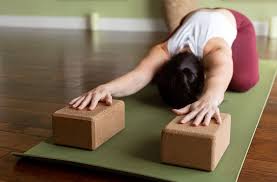
Inhale: 1-2-3-4-5. Exhale: 1-2-3-4-5. If you’ve been doing breathing exercises to feel calmer, happier, and more focused, you know how soothing yoga is.
Despite being an ancient practice, yoga has become increasingly popular, and for good reason. It is suitable for people of all ages and effective for treating chronic conditions.
Interestingly, scientists have discovered that this practice has several mental health benefits. Let’s explore the relationship between yoga and well-being, as well as the evidence-based benefits of yoga.

So, it’s THAT time of year again. The cards are out, flowers and chocolates in the shops, and the candlelit tables are all booked up weeks in advance. With good reason, many of us find it all rather superficial and insincere. Perhaps some of us might join the cynical chorus asking why we need a specific day to express our affection for someone else. We may even go as far as to accuse the the forces of capitalism of driving demand for “stuff”. But I’m not here to monologue on the meaningfulness of St. Valentine’s Day, and I’m certainly not here to criticise anyone for wanting to express themselves or to show affection for someone else (we all need to be doing this more, not less).
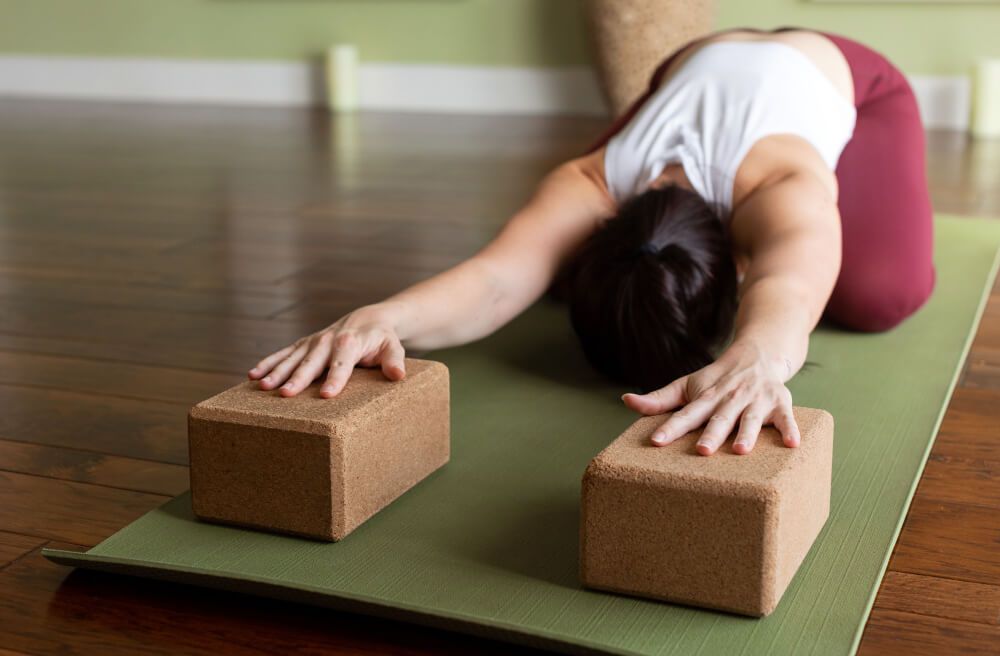
Can yoga reduce anxiety?Yes! Many studies have demonstrated the effectiveness of yoga in reducing stress, anxiety, and depression. In one study, women who participated in a three-month yoga program experienced significant improvements in perceived stress, anxiety, and depression. In another study, ten weeks of yoga helped reduce stress and anxiety for participants.

Happy New Year yogis! I’ve often found this time of year to be especially powerful in enhancing my yoga practice. Of course, yoga is always a powerful practice, but the gift of the new year brings deep reflection and introspection that can amplify processes of self-inquiry, expanding our spiritual awareness and commitment to yogic living.
